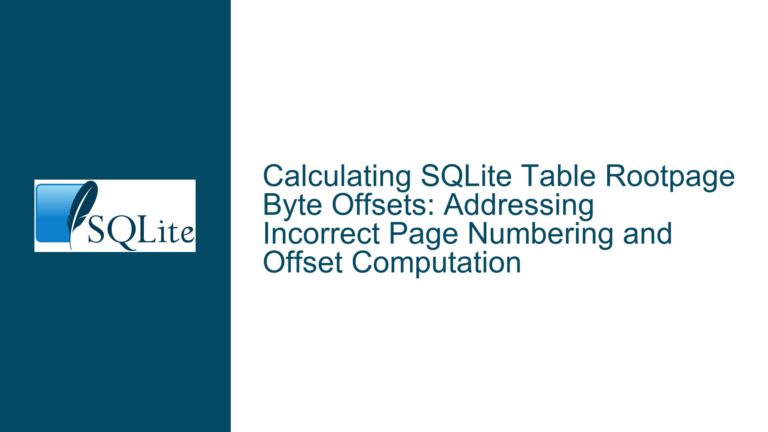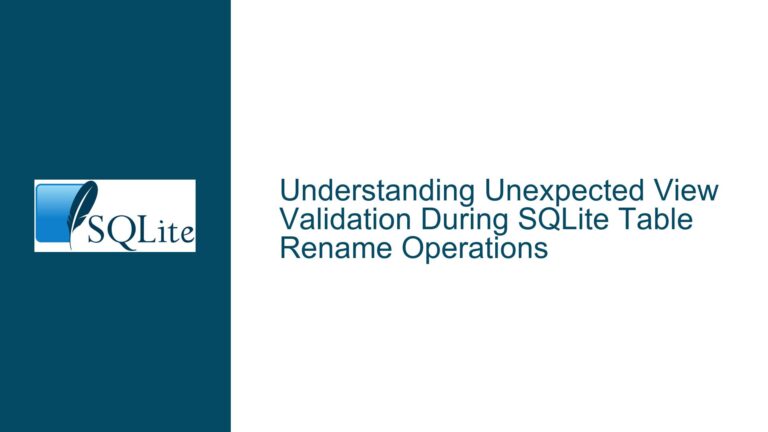SQLite Application ID: Registration, Usage, and Best Practices
The Role and Importance of Application IDs in SQLite Databases
The concept of an application ID in SQLite is a powerful yet underutilized feature that serves as a unique identifier for databases associated with specific applications. The application ID is a 32-bit integer stored in the database header, which can be set using the PRAGMA application_id command. This identifier is not enforced by SQLite itself but is intended for use by applications to quickly determine if a database file is of the expected type. For example, a database with an application ID of 0x53514152 (which translates to "SQAR" in ASCII) could be identified as belonging to the SQLAR (SQLite Archive) application.
The application ID is particularly useful in scenarios where multiple applications might interact with the same database files. By checking the application ID, an application can avoid accidentally opening or modifying a database that is not intended for it. This is especially important in environments where databases are shared or moved between different systems or applications. However, the application ID is not a security feature. It does not prevent tampering or ensure data integrity. For those purposes, SQLite’s encryption extension or other security measures should be employed.
Despite its utility, the application ID feature is often overlooked. Many applications do not set an application ID, and there is no formal process for registering or reserving specific IDs. This lack of standardization can lead to conflicts or confusion, especially as more applications begin to use this feature. The discussion around creating a registry for application IDs highlights the need for a more structured approach to managing these identifiers, ensuring that they are used effectively and consistently across different applications.
Challenges and Considerations in Establishing an Application ID Registry
One of the primary challenges in establishing a registry for SQLite application IDs is determining how to manage and allocate these identifiers. Unlike other registries, such as those managed by IANA for CBOR tags, a SQLite application ID registry would need to balance openness with practicality. The registry would need to be accessible to a wide range of users, including open-source projects, commercial applications, and individual developers, while also ensuring that IDs are allocated in a way that minimizes conflicts and confusion.
One proposed solution is to divide the 32-bit application ID space into reserved ranges for different types of applications. For example, IDs in the range 0-1023 could be reserved for default or system use, while higher ranges could be allocated to open-source projects, commercial applications, or private use. This approach would provide some structure to the allocation process, making it easier for developers to choose an appropriate ID for their application. However, it would also require careful management to ensure that these ranges are respected and that IDs are not reused or misallocated.
Another consideration is the administrative burden of maintaining such a registry. Managing a registry would require ongoing effort to ensure that IDs are allocated correctly, that conflicts are resolved, and that the registry remains up-to-date and accessible. This could be a significant commitment, particularly for a project like SQLite, which operates with a small team and a focus on stability and reliability. One possible solution is to delegate the management of the registry to a community group, rather than having it be directly managed by the SQLite project. This would allow the registry to operate independently, while still benefiting from the support and endorsement of the SQLite community.
Practical Steps for Implementing and Using Application IDs
For developers looking to implement application IDs in their SQLite databases, there are several practical steps to consider. First, it is important to choose an appropriate ID for your application. If a registry exists, developers should consult it to ensure that their chosen ID is unique and appropriate for their use case. If no registry exists, developers can use a method like generating a hash of their application name to create a unique ID. For example, using the command echo com.me.my.app | sha1sum | cut -c 1-4 would generate a 32-bit number that could serve as an application ID.
Once an ID has been chosen, it can be set in the database using the PRAGMA application_id command. For example, to set the application ID to 0x53514152, you would execute the following commands in the SQLite shell:
PRAGMA application_id = 0x53514152;
PRAGMA application_id;
This will set the application ID and then verify that it has been set correctly. It is also important to document the chosen ID and its significance, both within the application code and in any external documentation. This will help ensure that the ID is used consistently and that other developers understand its purpose.
In addition to setting the application ID, developers should also consider how to handle cases where the ID is missing or incorrect. For example, if an application opens a database and finds that the application ID does not match the expected value, it should handle this situation gracefully. This might involve prompting the user for confirmation, logging an error, or refusing to open the database altogether. By implementing these checks, developers can ensure that their applications interact with databases in a safe and predictable manner.
Finally, developers should be aware of the limitations of the application ID feature. As noted earlier, the application ID is not a security feature and does not prevent tampering or ensure data integrity. If these are concerns, additional measures such as encryption or checksums should be employed. Additionally, developers should be aware that the application ID is not included in the output of the .dump command in the SQLite shell. This means that if a database is backed up or migrated using this command, the application ID will need to be set again manually. By understanding these limitations and planning accordingly, developers can make the most of the application ID feature while avoiding potential pitfalls.
Conclusion
The application ID feature in SQLite is a valuable tool for identifying and managing databases associated with specific applications. However, its potential is currently underutilized due to the lack of a formal registration process and standardized best practices. By establishing a registry for application IDs and adopting a structured approach to their allocation and use, the SQLite community can unlock the full potential of this feature. Developers, in turn, can benefit from clearer guidelines and reduced risk of conflicts, making it easier to implement and use application IDs in their projects. While there are challenges to overcome, the benefits of a more organized and consistent approach to application IDs are clear, and the steps outlined above provide a roadmap for achieving this goal.






